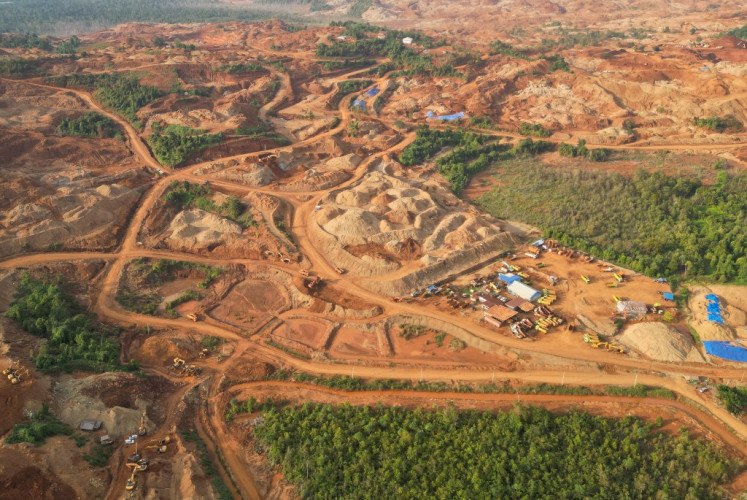Analysis: Improving Indonesia’s bouncy rubber industry
Ranked seventh in the list of Indonesia’s top export products last year, natural rubber and its derivatives play a significant role in the national economy
Change text size
Gift Premium Articles
to Anyone

Ranked seventh in the list of Indonesia’s top export products last year, natural rubber and its derivatives play a significant role in the national economy.
Indonesia’s natural rubber exports reached a value of US$3.4 billion in 2016 and contributed 2.3 percent to total exports. Currently, Indonesia is the second-biggest natural rubber exporter in the world, after Thailand.
Indonesia has 3.6 million hectares of rubber plantations, most of which are located in Sumatra, particularly in South Sumatra (900,000 ha). Unfortunately, only 83 percent of that total area has so-called mature trees, which consistently produce rubber latex.
As for ownership, most of the plantation area belongs to smallholders (84.4 percent), followed by private companies (9.2 percent) and the government (6.4 percent).
Rubber plantations employ almost 2.5 million workers across Indonesia. Bank exposure to this sector is substantial, with loans amounting to Rp 7.2 trillion ($541.59 million) for rubber plantations and Rp 9.5 trillion for the crumb industry, in total representing 0.4 percent of total disbursed loans in Indonesia.
Regardless of its significant contribution, the rubber industry faces severe problems that need to be addressed to support its growth. The issues are mainly due to low productivity and sluggish global demand.
Indonesia’s rubber productivity has been low for a very long time. Central Statistics Agency (BPS) data show that domestic rubber productivity stands at approximately 1 ton per ha, much lower than Thailand’s 1.6 tons per ha.
Ageing and increasingly damaged trees are the two main problems in the industry, which leads to higher production costs. The Indonesian government is aware of this issue and has made replanting a priority over the past years.
However, data show that the total area with young rubber trees is gradually declining. This means that the replanting program is not fast enough to replace the mature trees. On the other hand, the area of damaged trees keeps increasing, especially in the last couple of years.
Given these conditions, it comes as no surprise that Indonesia’s rubber plantation area has remained stagnant since 2013.
Another issue is weak global demand for the commodity, and the main concern here is with China, which accounts for almost 40 percent of worldwide rubber consumption.
The International Monetary Fund and the World Bank both projected a slowing economy for China in 2017 and 2018, which points to slower global rubber demand growth. On the other hand, however, motor vehicle sales in China surged 13 percent last year, indicating that rubber demand from the automotive industry, which is one of the biggest rubber consumers, will likely help demand for the commodity remain strong.
So why does global demand matter for the national rubber industry? To date, 80 percent of Indonesia’s natural rubber is shipped overseas, including to China.
Weaker global demand has forced prices to low levels, making it hard for players in the industry to survive, since production costs are also high.
Similarly, Thailand’s rubber industry also depends on exports, as 86 percent of its production is sent abroad. Thailand’s domestic market, however, is relatively strong with the presence of numerous automotive and tire manufactures. Furthermore, Indonesia’s competitors, such as Thailand, Vietnam and Malaysia, have a geographical advantage, as they are closer to China, hence lowering transportation cost.
To deal with such challenges, Indonesia needs to improve rubber productivity to reduce production costs. Therefore, when the price is in a low regime, our domestic rubber industry will survive in competition with other producers.
Collaboration between private companies and smallholder plantations, known as plasma plantations, has so far failed to significantly upgrade smallholders’ productivity. Replanting seems to be a better option, but since it is costly and lengthy, it will take years to see a tangible effect.
In addition, Indonesia should support the creation of new products made of rubber to strengthen its domestic market. Recently, the government has been conducting a pilot project to test the mixture of asphalt and rubber for road construction. If the result is positive, this initiative can be implemented throughout all government infrastructure projects.
Such a solution, however, would only work in a short term and will not amend Indonesia’s industrial structure in a sustainable manner. The establishment of more industries that absorb rubber, such as the automotive industry, is still the best long-term option.
Rubber farmers in Indonesia suffered declining prices from 2011 to 2015 after enjoying a commodity boom. In their mind-set the low price period will soon end and the boom period will once again come. However, if we look at the longer period, the commodity boom period was an anomaly, while the so-called low price period rather looks like the normal period. Therefore, they need to adapt to this condition. The sooner the better.
From 2016 to early 2017, global rubber prices hiked from $1.5 per kilogram to above $3 per kg. However, this rise was not fundamental, because it was caused by production cuts by Thailand, Indonesia and Malaysia under the Agreed Export Tonnage Scheme (AETS), with the expectation that China’s rubber stocks will slowly diminish.
This was proven when AETS ended in 2016 and rubber prices declined to $2 per kg. We see that this price level is high enough for local rubber farmers to maintain their businesses.
We predict that the price will fluctuate around the price of $2/kg throughout this year.
Considering the above challenges, government support and price outlook, Indonesia’s rubber industry will likely survive 2017 but will not shine as bright as other industries, such as CPO or even health care in terms of growth.
Indonesia is on the right track to reform its rubber industry, but not fast enough. The pace could be increased, of course, but the question is: Is it worth pursueing the market leader or is it enough to grow conservatively while gradually preparing the domestic rubber market?
______________________________________
The writer is an industry analyst at Bank Mandiri









